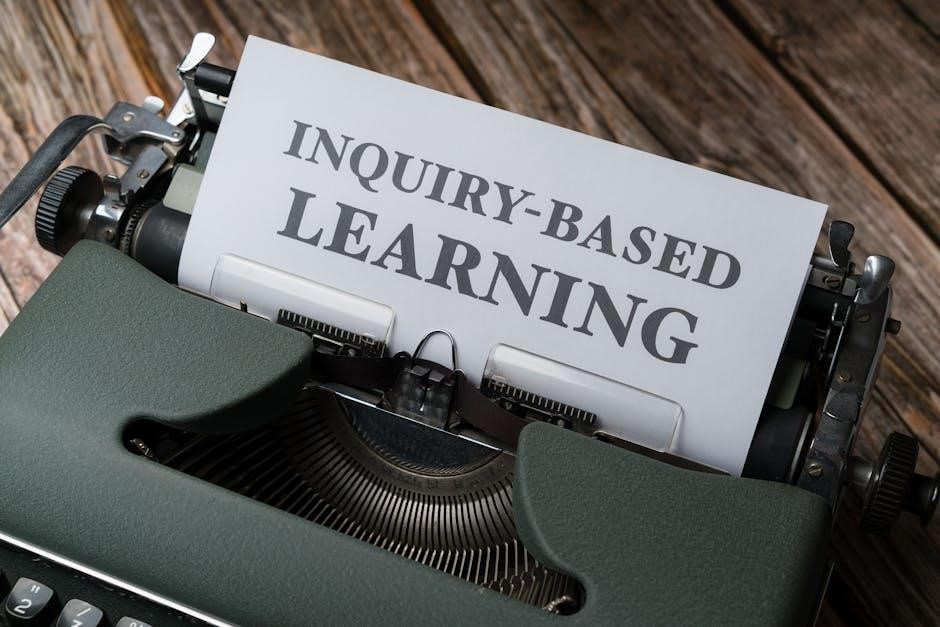Two-step word problems require students to use multiple operations to find the solution. These problems help 3rd-grade students develop math skills and logical thinking abilities.
Definition and Importance
Two-step word problems involve solving tasks that require two separate mathematical operations. They are essential for 3rd-grade students as they build foundational math skills. These problems enhance critical thinking and problem-solving abilities, preparing students for more complex concepts. By addressing real-world scenarios, they make math relevant and engaging. Solving two-step problems aligns with standards like 3.OA.D.8, ensuring students can apply operations effectively. Regular practice with such problems fosters confidence and fluency in math.
Relevance for 3rd Grade Students
Two-step word problems are highly relevant for 3rd graders as they bridge basic skills and more complex math. These problems introduce multi-operation tasks, preparing students for advanced concepts. They mirror real-life situations, making math practical and interesting. Solving such problems strengthens logical reasoning and mental math abilities. Worksheets and activities designed for this grade ensure a smooth transition from simple to challenging problems, fostering a solid math foundation and confidence in tackling varied scenarios.

Benefits of Solving Two-Step Word Problems
Solving two-step word problems enhances critical thinking and math fluency. It helps students apply math to real-life scenarios, preparing them for more complex challenges.
Development of Critical Thinking Skills
Solving two-step word problems challenges students to break down complex scenarios into manageable parts. This process fosters logical reasoning and analytical thinking. By identifying the operations needed and applying math concepts, students enhance their ability to approach problems methodically; Such exercises prepare them for real-world decision-making, where multiple steps are often required. Over time, this skill becomes second nature, boosting confidence and academic performance. The gradual exposure to these problems ensures a strong foundation for advanced math.
Application of Math in Real-Life Scenarios
Two-step word problems mirror real-life situations, such as shopping, budgeting, and event planning. For instance, calculating the total cost of groceries or determining the number of supplies needed for a party involves multiple math operations. These problems teach students to apply math skills pragmatically, preparing them for everyday challenges. By solving such problems, students learn to handle scenarios like splitting bills, measuring ingredients, or planning activities, making math a valuable tool for real-world tasks.
Preparation for More Complex Math Concepts
Solving two-step word problems helps students build a strong foundation in arithmetic and logical thinking. These problems introduce the concept of applying multiple operations in sequence, a skill essential for advanced math. By mastering two-step problems, students prepare for more complex concepts like algebra and multi-step equations. This gradual progression ensures they can tackle challenging math with confidence and accuracy.
Practicing these problems also enhances problem-solving strategies, making it easier to transition to higher-level math in later grades. This skill is crucial for long-term academic success.
How to Solve Two-Step Word Problems
To solve two-step word problems, students should read carefully, identify the operations needed, and break the problem into manageable parts. Using visual aids can help clarify the steps and ensure accuracy in the solution.
Step-by-Step Approach
A step-by-step approach is essential for solving two-step word problems. First, students should read the problem carefully to understand what is being asked. Next, they need to identify the key information and determine which operations are required. Breaking the problem into smaller, manageable parts helps simplify the process. Then, students should perform each operation sequentially, ensuring accuracy at each stage. Finally, they should review their work to verify that their solution makes sense in the context of the problem. This methodical process helps build confidence and improves problem-solving skills.
Identifying Key Information and Operations
Identifying key information and operations is crucial for solving two-step word problems. Students should carefully read the problem to pinpoint the numbers and actions involved. They need to recognize whether the problem requires addition, subtraction, multiplication, or division. Highlighting or underlining important details can help organize the information. Once the operations are identified, students can break the problem into smaller, manageable steps. This process ensures they understand what needs to be calculated and in what order, leading to an accurate solution. Clear identification of operations and information is foundational for success in these problems.
Using Visual Aids for Better Understanding
Visual aids like diagrams, charts, and models can significantly enhance understanding of two-step word problems. Drawing a picture or creating a bar model helps students visualize the problem. For example, representing groups with blocks or circles can simplify complex scenarios. These tools make abstract concepts more concrete, allowing students to break down problems into manageable parts. By organizing information visually, students can better identify the steps needed and perform the required operations effectively. Visual aids are particularly beneficial for hands-on learners and those who struggle with abstract thinking.

Example Problems and Solutions
For example, if Mrs. Horn needs 50 rulers and already has 7 boxes with 8 rulers each, students can calculate the total rulers she has and determine how many more are needed. This problem involves multiplication and subtraction, demonstrating how to break down two-step scenarios into manageable parts for 3rd-grade learners.
Addition and Subtraction Word Problems
Addition and subtraction two-step word problems involve combining or comparing quantities. For example, if a student has 15 pencils and receives 7 more, then gives away 5, they must add and subtract to find the final count. These problems enhance understanding of basic operations and real-world application, crucial for 3rd-grade math skills. Worksheets and online tools provide ample practice, ensuring students master these essential problem-solving techniques in a structured and engaging manner.
Multiplication and Division Word Problems
Multiplication and division two-step word problems challenge students to apply these operations in sequence. For instance, if a bakery sells 12 cupcakes in 4 rows and then needs to package 24 cupcakes into boxes of 6, students must multiply and divide. These problems build proficiency in higher-order thinking and math fluency, essential for 3rd-grade students. Practice worksheets and interactive tools help reinforce these skills, preparing students for more complex math concepts in later grades through practical, real-world scenarios.
Mixed Operation Word Problems
Mixed operation word problems combine addition, subtraction, multiplication, and division in a single scenario. For example, if a student has 18 pencils, gives 4 to a friend, and then divides the rest equally among 5 classmates, they must subtract and divide. These problems enhance critical thinking and math fluency. Worksheets and guides provide practice, helping students master multi-step solutions. Real-world examples, like calculating total items after sharing, make learning engaging and practical for 3rd-grade students.

Common Challenges in Two-Step Word Problems
Students often struggle with identifying the correct operations and keeping track of multiple steps. Understanding the problem’s context can also be confusing for young learners.
Identifying the Correct Operations
Identifying the correct operations is a key challenge in two-step word problems. Students must carefully read the problem to determine which math operations are required. Sometimes, the problem may involve addition followed by subtraction or multiplication followed by division. For example, if a problem states that “Mrs. Horn needs 50 rulers and already has 7 boxes with 8 rulers each,” students must first multiply to find the total number of rulers she has (7 * 8) and then subtract that from 50 to find out how many more rulers she needs. This requires a deep understanding of the relationships between numbers and operations. Visual aids like diagrams or equations can help students break down the problem into manageable steps. Additionally, teaching students to underline or highlight key words that indicate operations (e.g., “has,” “needs”) can improve their ability to identify the correct steps. With practice, students can become more confident in selecting the appropriate operations for each problem.
Keeping Track of Multiple Steps
Keeping track of multiple steps in two-step word problems can be challenging for students. To help manage this, teachers often use visual aids like diagrams or equations. Breaking the problem into smaller parts allows students to focus on one step at a time. For instance, in a problem involving addition and subtraction, students can first calculate the total and then find the difference. Writing down each step as they go helps prevent confusion. Additionally, using real-life examples makes the problems more relatable and easier to follow, ensuring students stay engaged and understand the process clearly.
Understanding the Context of the Problem
Understanding the context of two-step word problems is crucial for 3rd-grade students. The ability to visualize the scenario and identify what is being asked helps students choose the right operations. Reading the problem carefully and underlining key information can make the process clearer. Real-life examples, such as shopping or event planning, make the problems more relatable. When students can connect the math to meaningful situations, they are more likely to engage and solve the problems confidently. This skill builds a strong foundation for more complex math in the future.
Practice Resources and Worksheets
Printable PDF worksheets and interactive online tools provide excellent practice for solving two-step word problems. These resources include solutions, making them ideal for independent study and classroom use.
Printable Worksheets for 3rd Grade
Printable PDF worksheets are designed to help students practice solving two-step word problems. These worksheets cover various math operations, including addition, subtraction, multiplication, and division. They often include example problems to guide students and answer keys for review. Topics range from shopping scenarios to everyday situations, making learning engaging and relevant. Regular practice with these worksheets enhances problem-solving skills and builds confidence in tackling multi-step math challenges.
Interactive Online Tools and Games
Interactive online tools and games make learning two-step word problems engaging for 3rd-grade students. These resources often include timers, rewards, and levels to keep students motivated. Many platforms offer puzzles, problem-solving challenges, and real-life scenarios that require applying math skills. Games like “Math Adventure” or “Word Problem Quest” allow students to practice solving problems in a fun and competitive way. These tools provide immediate feedback, helping students identify areas for improvement and track their progress over time.
PDF Guides with Answers
PDF guides with answers are excellent resources for practicing two-step word problems. They provide clear examples, step-by-step solutions, and answers for reference. These guides are ideal for 3rd-grade students to improve their problem-solving skills. Many PDFs include a variety of problems covering addition, subtraction, multiplication, and division. Teachers and parents can use these guides to create structured practice sessions. The inclusion of answers allows students to check their work and understand their mistakes. These printable resources are a convenient way to reinforce learning and build confidence in solving complex problems.

Real-World Applications of Two-Step Word Problems
Two-step word problems are used in shopping, planning events, and everyday scenarios, helping students apply math to real-life situations like calculating totals, measuring materials, or dividing resources.
Shopping and Budgeting
Two-step word problems are essential in shopping and budgeting, helping students calculate totals, compare prices, and measure quantities. For example, if a shopper buys 5 apples at $2 each and 3 bananas at $1 each, they can determine the total cost. These problems teach financial literacy and practical math skills, preparing students for real-life scenarios like grocery shopping or planning purchases within a budget. Worksheets and PDF guides provide practice with such scenarios, making math relevant and engaging for 3rd graders.
Planning Events and Activities
Two-step word problems are valuable for planning events, such as parties or school activities. Students can calculate the number of chairs needed for 20 guests plus 5 extra chairs or determine the total time for a 2-hour movie plus a 30-minute setup. These problems help students organize and manage real-life tasks, such as preparing for a bake sale or arranging seats for a performance. Worksheets and PDF guides provide practice scenarios, enabling students to apply math to practical planning situations, enhancing their problem-solving and organizational skills.
Everyday Problem-Solving Scenarios
Two-step word problems often reflect real-life situations that require mathematical thinking. For example, calculating the total cost of groceries after discounts or determining the time left for a task after interruptions. These problems help students apply math to daily situations, such as saving money, cooking, or planning activities. Worksheets and PDF guides provide practical exercises, enabling students to solve everyday challenges like splitting candies fairly or measuring ingredients for a recipe. This makes math relevant and useful in their lives, fostering a deeper understanding of problem-solving techniques and their real-world applications.
Assessment and Feedback
Evaluate students’ understanding of two-step word problems using quizzes, worksheets, and projects. Provide constructive feedback to improve problem-solving skills and track progress over time with detailed assessments.
Methods to Evaluate Understanding
Evaluate students’ grasp of two-step word problems using quizzes, worksheets, and interactive online tools. Assign printable PDF worksheets with answers to assess problem-solving skills. Use mini-assessments aligned with standards like 3.OA.D.8 to measure understanding. Incorporate visual aids and real-life scenarios to make evaluations engaging. Provide immediate feedback through answer keys and explanations. Track progress by reviewing completed worksheets and observing improved accuracy in multi-step problems. Utilize games and activities to make assessments fun and motivational for 3rd-grade students.
Providing Constructive Feedback
Offer clear and specific feedback to help students improve. Highlight strengths, such as correctly identifying operations, and gently point out areas for growth. Use visual aids to explain mistakes and provide examples of correct problem-solving methods. Encourage students to reflect on their work and ask questions to deepen understanding. Positive reinforcement motivates learners, while actionable advice guides them toward mastery of two-step word problems.
Tracking Progress Over Time
Regularly monitoring students’ improvement in solving two-step word problems is essential. Use worksheets and PDF guides to assess their understanding over time. Track correctness, speed, and problem-solving strategies. Identify areas where students struggle and provide targeted support. Celebrate progress to boost confidence. Maintaining a record of completed problems helps teachers and parents see growth. This consistent feedback loop ensures students stay on track and master two-step word problems effectively.
Mastering two-step word problems boosts math confidence and critical thinking in 3rd graders. Regular practice with PDF guides ensures long-term skill development and academic success.
Two-step word problems are essential for developing math skills in 3rd graders, requiring multiple operations and critical thinking. These problems enhance problem-solving abilities, real-life application, and math confidence. Regular practice with PDF guides, worksheets, and interactive tools helps students master these concepts. Understanding operations, identifying key information, and using visual aids are crucial strategies. Consistent effort builds a strong foundation for more complex math, preparing students for future academic success and practical applications in everyday scenarios.
Encouragement for Continued Practice
Consistent practice with two-step word problems builds confidence and math fluency in 3rd graders. Celebrate small victories and emphasize progress, not perfection. Encourage students to use worksheets, online tools, and real-life examples to make learning engaging. Praise their effort and persistence, highlighting how these skills benefit everyday situations. Remind them that practice is key to mastering more complex math concepts. Keep it fun and rewarding, ensuring they stay motivated to improve their problem-solving abilities and develop a strong math foundation for the future.
